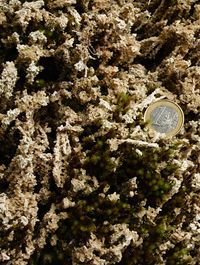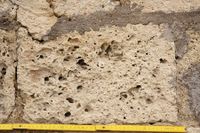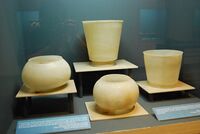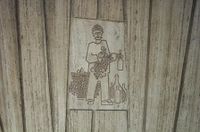تراڤرتين
التراڤرتين Travertine هي صخر رسوبي كثيفٍ متماسكٍ من أشكال الحجر الجيري، ويوجد في معظم الأحيان على شكل طبقات ينضمُّ بعضها إلى بعض. ويكون معظم الترافرتين ذا لون أبيض أو أبيض مائل للصفرة. ويتكون بصورة رئيسية من كربونات الكالسيوم، ويتشكَّل حينما تنفصل كربونات الكالسيوم عن الماء من خلال التبخر. ويُستعمل الترافرتين في تزيين الأبنية بسبب سهولة قطعه.
وينشأ الترافرتين في المناطق التي يتوافر فيها الحجر الجيري، حيث يحوي ماء الأرض الجاري كربونات الكالسيوم. ويتشكل عادة حول مَصابّ الينابيع الحارة، وفي داخل الجداول. وتحتوي تكوينات الصخور في الكهوف، والتي يُطلق عليها اسم الهوابط والصواعد، على الترافرتين بصورة رئيسية.
الاستخدام كمادة بناء
Travertine is often used as a building material. It typically lacks planes of weakness, and its high porosity makes it light in weight for its strength, gives it good thermal and acoustic insulating properties, and makes it relatively easy to work. Dense travertine makes excellent decorative stone when polished.[1]
The Romans mined deposits of travertine for building temples, monuments,[2] aqueducts,[3] bath complexes,[4] and amphitheaters such as the Colosseum,[5] the largest building in the world constructed mostly of travertine.[6] In Italy, well-known travertine quarries exist in Tivoli and Guidonia Montecelio, where the most important quarries since Ancient Roman times can be found.[7] The Tivoli quarries supplied the travertine from which Gian Lorenzo Bernini selected material from which to build the famous Colonnade of St. Peter's Square in Rome (colonnato di Piazza S. Pietro) in 1656–1667.[8] Michelangelo also chose travertine as the material for the external ribs of the dome of St Peter's Basilica.[9]
Travertine regained popularity as a building material in the Middle Ages.[10] The central German town of Bad Langensalza has an extant medieval old town built almost entirely of local travertine.[بحاجة لمصدر] 20th Century buildings using travertine extensively include the Sacré-Cœur Basilica in Paris, the Getty Center in Los Angeles, California, and Shell-Haus in Berlin. The travertine used in the Getty Center and Shell-Haus constructions was imported from Tivoli and Guidonia.[11]
Travertine is one of several natural stones that are used for paving patios and garden paths.[12] It is sometimes known as travertine limestone or travertine marble; these are the same stone, although travertine is classified properly as a type of limestone, not marble. The stone is characterised by pitted holes and troughs in its surface. Although these troughs occur naturally, they suggest signs of considerable wear and tear over time. It can also be polished to a smooth, shiny finish, and comes in a variety of colors from grey to coral-red. Travertine is also available in tile sizes for floor installations.[13][14]
Travertine is one of the most frequently used stones in modern architecture. It is commonly used for indoor home/business flooring, outdoor patio flooring, spa walls and ceilings, façades, and wall cladding. The lobby walls of the modernist Willis Tower (1970) (formerly Sears Tower) in Chicago are made of travertine.[15] Architect Welton Becket frequently incorporated travertine into many of his projects.[16] The Ronald Reagan UCLA Medical Center is clad with over 3 million pounds (about 1360 tonnes) of Ambra Light travertine from the Tivoli quarries.[17] Architect Ludwig Mies van der Rohe used travertine in several of his major works, including the Toronto-Dominion Centre,[18] S.R. Crown Hall,[19] the Farnsworth House[20] and the Barcelona Pavilion.[21]
The New Mexico State Capitol has its rotunda finished with travertine[22] mined from a deposit west of Belen, New Mexico. Stone from this quarry is also used in buildings at the University of New Mexico.[23][24]
قلعة بورگهاوزن، أطول قلعة في اوروبا، عمرها 1,000 سنة وبُني معظمها من التراڤرتين.
Travertine vessels found in El Tapesco del Diablo Cave in Ocozocoautla, Chiapas، المكسيك (600–900 CE)
انظر أيضًا
المصادر
- ^ Pentecost 2005, p. 319.
- ^ Jackson, M. D.; Marra, F.; Hay, R. L.; Cawood, C.; Winkler, E. M. (August 2005). "The Judicious Selection and Preservation of Tuff and Travertine Building Stone in Ancient Rome". Archaeometry. 47 (3): 485–510. doi:10.1111/j.1475-4754.2005.00215.x.
- ^ Korkanç, Mustafa (February 2018). "Characterization of building stones from the ancient Tyana aqueducts, Central Anatolia, Turkey: implications on the factors of deterioration processes". Bulletin of Engineering Geology and the Environment. 77 (1): 237–252. doi:10.1007/s10064-016-0930-2. S2CID 133259664.
- ^ Van der Meer, L.B.; Stevens, N.L.C. (2000). "Tiburtinus Lapis: the use of travertine in Ostia". Babesch. 75: 180.
- ^ Rose, Simon (2019). Colosseum. New York, NY: AV2 by Weigl Publishers. p. 15. ISBN 9781489681652.
- ^ "The History Of The Tile". Archived from the original on February 28, 2014 – via www.youtube.com.
- ^ "quarry Bernini in Guidonia". Archived from the original on February 8, 2011.
- ^ D’Amelio, M.G. (2003). "The construction techniques and methods for organizing labor used for Bernini's colonnade in St. Peter's, Rome". Proceedings of the First International Congress on Construction History. 20 p: 697.
- ^ Como, Mario (2016). "Masonry Vaults: General Introduction". Statics of Historic Masonry Constructions. Springer Series in Solid and Structural Mechanics. 5: 177–184. doi:10.1007/978-3-319-24569-0_4. ISBN 978-3-319-24567-6.
- ^ Pentecost 2005, pp. 327-328.
- ^ "The Getty Center" Archived 2011-06-07 at the Wayback Machine, Official Website
- ^ Ruseva, Kremena (2 October 2015). "Travertine pavers for patio and driveways – the ideal landscaping stones". Dea Vita. Retrieved 16 July 2021.
- ^ Yuri, Shauna (9 June 2021). "Pros, Cons, and Installation Tips for Travertine Tiles". Unhappy Hipsters. Retrieved 16 July 2021.
- ^ Lewitin, Joseph. "Travertine Flooring Review: Pros and Cons". The Spruce. Dotdash. Retrieved 16 July 2021.
- ^ "The Willis Tower" Archived 2009-11-26 at the Wayback Machine, Official Website
- ^ French, C. M.; Stiles, E.B. (2010). "Los Angeles modern: City of tomorrow". Architecture, Art, and Historic Preservation Faculty Publications. Washington DC: National Trust for Historic Preservation. Retrieved 16 July 2021.
- ^ Richinelli, Jennifer (1 October 2007). "Roman travertine makes medical center "a pillar of strenght"". Stone World. BNP Media. Retrieved 16 July 2021.
- ^ Gee, Marcus (1 May 2015). "Five things the TD Centre can teach us about how to build Toronto". The Globe and Mail Toronto. Retrieved 16 July 2021.
- ^ "Chicago landmark, S.R. Crown Hall, receives National Historic Landmark Status". Illinois Tech. Illinois Institute of Technology. 1 June 2014. Retrieved 16 July 2021.
- ^ Bey, Lee (Fall 2020). "The Past, Present, and Future of Farnsworth House". Preservation Magazine. National Trust for Historic Preservation. Retrieved 16 July 2021.
- ^ Glancey, Jonathan (21 October 2014). "Why the 'Barcelona' Pavilion is a modernist classic". BBC Culture. BBC. Retrieved 16 July 2021.
- ^ "New Mexico State Capitol". Tourism Santa Fe. City of Santa Fe. Retrieved 3 August 2021.
- ^ Priewisch, A.; Crossey, L. J.; Karlstrom, K. E.; Polyak, V. J.; Asmerom, Y.; Nereson, A.; Ricketts, J. W. (1 April 2014). "U-series geochronology of large-volume Quaternary travertine deposits of the southeastern Colorado Plateau: Evaluating episodicity and tectonic and paleohydrologic controls". Geosphere. 10 (2): 401–423. Bibcode:2014Geosp..10..401P. doi:10.1130/GES00946.1.
- ^ Austin, George S.; Barker, James M. (August 1990). "Commercial travertine in New Mexico" (PDF). New Mexico Geology. 12 (3): 49–58. Retrieved 3 August 2021.
- Hurlbut, Cornelius S.; Klein, Cornelis, 1985, Manual of Mineralogy, 20th ed., Wiley, p. 496 ISBN 0-471-80580-7
وصلات خارجية
| Travertine
]].




